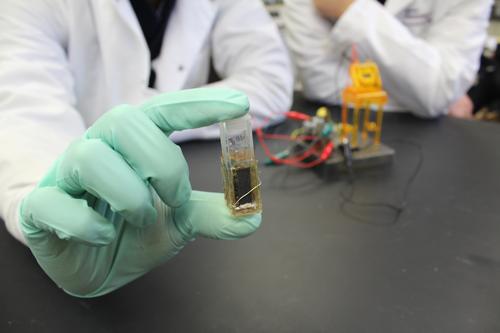September 5, 2014

A researcher at Virginia Tech has developed a bio-battery that turns sugar into energy and has up to 10 times the energy density of lithium-ion batteries.
The battery -- which uses maltodextrins, polysaccharides made from the partial hydrolysis of starch, as its energy source -- is the work of Y.H. Percival Zhang, an associate professor of biological systems engineering in the Virginia Tech College of Agriculture and Life Sciences and the College of Engineering.
He revealed his invention in an article published in the journal Nature Communications in January, and is currently developing the battery at Cell-Free Bio Innovations, a commercial spinoff from Virginia Tech.

The battery is a fuel cell that uses enzymes from sugar instead of platinum as catalysts, he told Design News in an interview. "We build a synthetic pathway that can completely convert chemical energy in sugars to electricity for the first time."
The pathway strips all charge potentials from the sugar to generate electricity in an enzymatic fuel cell. It also uses low-cost biocatalyst enzymes instead of platinum, which is typically used in conventional batteries. While maltodextrin is the fuel source for the cell, sucrose also is an option, and Zhang and researchers at Cell-Free Bio Innovations also are working to create a battery based on coca, Zhang said.
Because the design is a fuel cell, the energy density of the bio battery is potentially much higher than typical lithium-ion batteries -- in this case, up to 10 times higher, Zhang told us. "Fuel cells always have higher energy densities than battery," he explained. "In our case, we do not need let the sugar solution follow through catalysts. Indeed, we can add sugar once and let it release its energy step by step. It is like humans who eat food three times per day and work the whole day. Here we use a slowly-utilized sugar as an energy source."
There are a number of other benefits a sugar-based battery has over typical lithium-ion or other cells, Zhang said. The most obvious one is that it's non-toxic, because it doesn't use metals, and it's also non-flammable, as lithium-ion batteries have shown to be with sometimes-disastrous results. Disposal of used batteries also is quite simple, as the cells are biodegradable, he added.
The cell designed by Zhang also refills within several seconds, far more quickly than the average battery.
On the downside, the power output of the battery is still quite low and it does not have a long lifetime. Currently, the power density of the cell is 0.4 mW/cm2 -- enough to power an LCD light and digital clock, Zhang told us. "If we want to power a smartphone, we need to increase power density by five- to 10-fold," he said. The team is working to solve both of these problems.
Cell-Free Bio Innovations hopes to have a prototype of a viable cell for commercialization in three years. Applications for the battery include mobile devices as well as other portable electronics.
Related posts:
Anagear's Low-Power Circuits Harvest & Save Energy
Looking Ahead to the 2015 Bridgestone World Solar ChallengeUpdate: Racing in Bridgestone's 2013 Solar World ChallengeSiemens Helps Student Engineers Race in the OutbackEngineers Eye the Prize in Solar Car Road ChallengeComposites Lighten Solar CarMIT Research Could Dramatically Improve Solar Cell Efficiency Energy Harvesting Empowers Next-Gen Wireless Designs & AutomationTI Offers Low-Power Converter to Advance Design of Energy-Harvesting ElectronicsStanford Engineers Invent All-Carbon Solar CellRechargeable Lithium-Ion Cells for Remote Wireless ApplicationsOpen-Source Kits Put Robots in Many HandsSparkFun Takes Electronics to Future Engineers & ScientistsNanodevices Self-Assemble Using DNAUS Army's Boot-Based Energy Harvester Lightens Soldier's LoadEnergy-Harvesting Soccer Ball Gets a KickstartRobotic Solar Panels Produce More ElectricityQBotix Receives $1M From DoE to Advance Robotic Solar-Panel TechnologyResearchers Develop Recyclable Solar Cells From TreesStraw Lampshade-Like Cover Turns Skyscraper Into Energy HarvesterEnecsys Unveils Next-Generation Global Micro Inverter PlatformEngineers Eye the Prize in Solar Car Road Challenge100-Percent Solar Plane Flies High on Advanced MaterialsSlideshow: Upping the Efficiency of Solar Cells
About the Author(s)
You May Also Like



